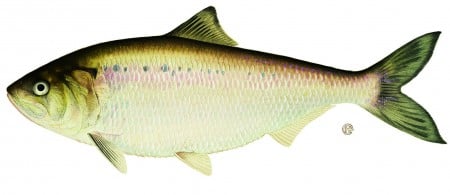The Opportunity in a New River Restoration Plan
From the perspective of an American shad, that iconic, depleted fish of the estuary, the Hudson River today is far different, and in many ways far less hospitable, than in times past. We’ve made tremendous progress improving water quality since the passage of New York’s landmark Pure Waters Bond Act 50 years ago, and the federal Clean Water Act a few years later. But if raw sewage doesn’t rob the river of oxygen as it did for decades prior to the implementation of those laws, other basic building blocks of life for shad and other river wildlife still remain sorely disabled.
We’ve restored their air supply, but so far done little to give them back space enough to live, untrammeled nurseries for their young, or ensured conditions are adequate to produce enough food for them to eat. We’ve only recently stopped overfishing them with industrial-sized ships in the Atlantic, before they can spawn, or stopped plucking those few who return to the river from their spawning grounds.
More than 4,000 acres of shallow water habitat critical to Hudson River fish has been destroyed in the upper third of the estuary alone–along with a staggering 71 miles of shoreline lost to dredging, filling and other activities, according to the recently finalized Hudson River Estuary Habitat Restoration Plan from the DEC’s Hudson River Estuary Program. Overall, half of the Hudson River shoreline between the Tappan Zee and Troy has been altered, often to the detriment of the fish like shad and their young, which rely on the river’s shallows to survive. The invasion of zebra mussels quite literally left the young of many river fish to starve, as the hungry bivalves siphoned off the plankton that serves as food for both. (Though there’s recent evidence from work done at the Cary Institute that a fundamental shift in this competition has come, in part at the claws of our blue crabs, and our young fish are fattening up again.)
That’s why the Hudson River Comprehensive Restoration Plan holds so much promise. Like the Humpty Dumpty rhyme my three-year-old has been reciting recently, we can’t put all these pieces that made wildlife in this river so abundant back together again. But we can significantly improve conditions and undo some of the damage from four centuries of development and exploitation that were carried out–until very recently, in historical terms–with no regard for the longterm health of the river’s ecology. The list of projects financed to actually restore habitat in the Hudson River is very small.
Building on the work of the similarly titled report referenced above, the Comprehensive Restoration Plan aims to produce an actionable list of projects, in order to access expected funding from the Army Corps of Engineers. A similar project, on a far bigger scale, has been aiding the Chesapeake Bay restoration for years.
Riverkeeper has been participating in the effort, and our goals will revolve around ensuring that all available money is spent according to the original mission of the project — to restore river habitats, for the benefit of the river. There are many other funding streams and projects designed to benefit our use of the river — this is one that should be reserved for the river, first.
Several events are scheduled this month to inform the public about the project. Please attend, learn, and support efforts that put the river first. The information sessions scheduled include:
Tuesday, January 13, 4-5:30 PM and 6-7:30 PM (Two sessions)
Columbia-Greene Community College, 4400 Route 23 – Professional Academic Building Room 612, Hudson, NY
Wednesday, January 14, 4-5:30 PM and 6-7:30 PM (Two sessions)
Marist College, 3399 North Road, Poughkeepsie, NY
Thursday, January 15, 4-5:30 PM and 6-7:30 PM (Two sessions)
Irvington Public Library, 12 South Astor Street, Irvington, NY
Wednesday, January 21, 11:30 AM – 1 PM
Via Webinar (Register here)
Thursday, January 22, 4-5:30 PM and 6-7:30 PM (Two sessions)
East Greenbush Community Library, 10 Community Way, East Greenbush, NY

